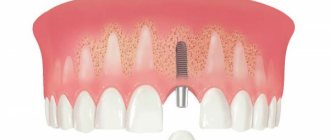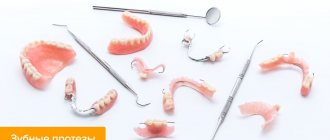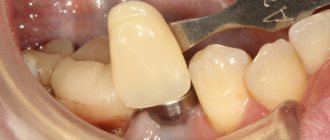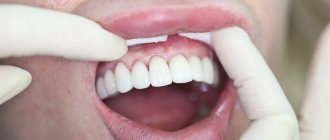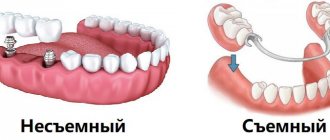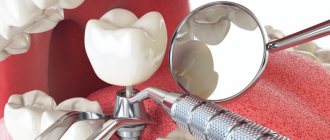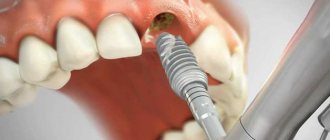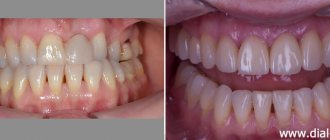Implantation without an incision is a marketing name that reflects the meaning of the procedure. This type of implant installation is also called transgingival, endoscopic, non-surgical or bloodless. This treatment has been known in Europe for 15 years , in Russia - relatively recently, but the popularity of the method is growing.
The process of installing an implant without an incision
What is implantation without a gum incision?
First, let's figure out what classical implantation is. This protocol involves the introduction of a titanium root (implant) into the bone tissue at the site of the missing tooth. The surgeon acts like this:
- Cuts the mucous membrane.
- Folds back the gingival flap.
- If necessary, it builds up bone tissue.
- Places an implant.
- Places stitches.
- After the implant has healed, a permanent crown is installed.
Tooth restoration takes 5-6 months , since it requires healing of the gums, fusion of the implant with the bone tissue, and installation of a crown after osseointegration.
Unlike the classical method, implantation without incisions allows you to skip several stages and avoid large incisions in the gums:
- To install the implant, one hole with a diameter of several millimeters is made.
- The implant is implanted.
- A gum former or temporary lightweight crown is immediately installed.
- After the implant has healed, a permanent crown is fixed in 2-3 months .
This treatment is recommended:
- people with diseases of the endocrine and cardiovascular systems;
- for those who are against surgery.
The bloodless method accelerates the restoration of the dentition.
Features of the method
The method is not suitable for patients with bone deficiency for reliable fixation of an artificial rod. It is impossible to increase bone mass without making an incision in the gums, so non-surgical treatment is available to only 5% of people.
The volume of the mucous membrane is also taken into account. If the gum thickness is less than 2 mm, an implant cannot be installed using a non-surgical method. Under the influence of the titanium root, the mucous membrane will stretch and become even thinner. The thinner the gums, the greater the risk of inflammatory processes and implant rejection. The fact is that opportunistic bacteria, which are normally found in the oral cavity, can seep through the thin soft tissue and destroy the bone underneath. For thinned gums, we recommend enlarging the incision and performing implantation using a patchwork method.
In our Center, implantation without incisions is not covered by a lifetime guarantee.
Related articles:
- Other implantation methods
- Our guarantees
- Implant lifespan
Compliance with conditions
Dental implantation
non-surgical method, or as it is also called, transgingival, has contraindications:
- Inflammatory process in the periodontal area (exacerbation);
- Insufficient tissue volume - bone and soft;
- Poor bone quality in the area where the tooth is missing;
- Poor performance of primary implant stabilization.
Contraindications can be relative and absolute, general and local, and are temporary. For more details, it is better to consult your doctor!
We must not forget that despite the huge number of advantages, this is still an operation. This means that you need to take a responsible approach to choosing a dentist. A competent implantologist will assess all possible risks.
Implantation using the incisionless technique: absolute contraindications:
- Diseases of the blood and hematopoietic organs;
- Mental problems;
- Connective tissue diseases;
- Malignant tumors;
- Tuberculosis, including complicated;
- Poor immunity;
- Diabetes;
- Bruxism;
- Allergy to drugs used;
- Endocrine disorders;
- Osteoporosis.
Relative contraindications:
- Caries;
- Poor oral hygiene;
- Pathological bite;
- Inflammation of the gums;
- Arthrosis of the jaw joints;
- Periodontitis;
- Pregnancy;
- Smoking, alcoholism, drug addiction;
- Atrophied alveolar processes of teeth.
Relative means contraindications that can be overcome.
What does smoking have to do with it? A smoker is more likely to experience implant failure than the average person. This is why it is recommended to give up cigarettes two weeks before the procedure.
General contraindications:
- Allergy to anesthetics;
- General somatic diseases;
- Taking medications prescribed by other doctors;
- Unstable psychological state due to stress;
- Exhaustion.
Local contraindications:
- Bone atrophy in the area where the implant is planned to be placed;
- The gap between the working area and the maxillary and nasal sinuses is too small.
- Temporary contraindications:
- Diseases in the acute stage;
- Rehabilitation period;
- Recent radiation therapy;
- Alcoholism.
Stages of bloodless implantation
With the seamless method, the implant is inserted through a puncture of the gum. Before the puncture, local anesthesia is given or the patient is put into medicated sleep.
- Using a circular mucotome, a circular incision is made for the titanium root. Preparing the hole begins by marking it with a ball bur. Sequential expansion is carried out using cutters of different diameters - from smaller to larger.
- Installation of an artificial root into the bone mass by screwing.
- Fixation of the healing abutment or abutment.
- It is possible to install a temporary lightweight crown immediately. After osseointegration, it is replaced with a permanent one.
Indications and contraindications
Implantation of an artificial root is used to restore lost teeth. Indications for use of the procedure:
- Missing one or more teeth;
- The need for rapid recovery;
- Absence of extreme dental units;
- Edentia.
Non-surgical dental implantation has a number of contraindications. It is strictly forbidden to carry out the procedure for people suffering from diseases of the gums, oral cavity, internal organs and circulatory system. It is not allowed to carry out the process of installing implants on patients who have been diagnosed with malignant processes in the body. In addition, contraindications apply to pregnant and breastfeeding women.
Features of the operation in our Center
- We begin transgingival implantation by creating a 3D model of the jaw. Our Center uses the “Nobel Guide” system. She creates an accurate virtual model based on mathematical calculations and produces a surgical template. With it, the doctor will determine where and at what distance to place the implants without cutting the gums. A tomograph and an X-ray machine do not provide such accuracy. The very name “implantation without incision” was invented by marketers to promote the “Nobel Guide” protocol.
- When the surgical template is ready, the doctor places it firmly against the gum and makes one or more holes for the implants. The procedure is performed under local anesthesia or sedation and is painless for the patient.
- After inserting the rod, the doctor places a temporary crown if the tooth is in the smile zone.
- After 2-3 months, the patient comes to the clinic for the second time and leaves with a permanent crown, indistinguishable from a natural tooth. In classical technology, the last visit takes place six months after the start of treatment.
Rehabilitation period
Rehabilitation with the sutureless method takes less time compared to classical implantation. The operation is minimally invasive, without stitches, and therefore the implants take root quickly.
The risk of complications is minimal, since surgical manipulations practically do not injure fibrous tissue. But this does not mean that in the postoperative period the patient should not follow a certain regimen:
- On the recommendation of a doctor, antibacterial therapy, anti-inflammatory and painkillers are prescribed.
- On the first day you should not eat solid food.
- On the second day, if there is no pain, swelling and temperature, the gentle regime and anti-inflammatory drugs are canceled.
Benefits of non-surgical implant installation
- The time to restore the dentition is reduced: after a maximum of 3 months, the patient is fitted with a permanent crown.
- The operation is faster: installing the rod using the classical method takes up to 8 minutes, and using the bloodless method – up to 2 .
- Rehabilitation is made easier: patients do not experience bruises, swelling, pain, or fever, and can work the next day after the implants are installed. It is especially important when restoring several teeth.
- The risk of implant rejection and infection is reduced since it does not require separation of the gum from the bone.
- Takes 10-15 minutes . Unlike the classic 3-stage method, with a non-surgical method the doctor installs a gum former or temporary crown immediately, without waiting for healing. The rehabilitation period is reduced by 2-2.5 times .
Where is the dentistry located?
We are located a five-minute walk from the Shchelkovskaya metro station (exit No. 1). or for more information, you can call 8 (495) 033-00-63 (Cherkizovskaya, Preobrazhenskaya Square, Pervomaiskaya, Izmailovskaya, Shchelkovskaya). We work seven days a week. We accept cash and bank cards for payment.
Our clinic is located in the Eastern Administrative District of Moscow
at Shchelkovskoe highway, house 44, building 5. It is near the metro stations Shchelkovskaya, Cherkizovskaya, Preobrazhenskaya Square, Pervomaiskaya, Izmailovskaya. Near us are the districts of Golyanovo, Northern Izmailovo, and Southern Izmailovo. We work seven days a week. We accept cash and bank cards for payment.
Sign up
Or call us 8 (495) 033-00-63
Price
Speed of the procedure does not mean cheaper. The amount of consumables and the cost of doctors’ work does not decrease. On the contrary, the price of implantation without an incision is higher due to:
- manufacturing a surgical template;
- mandatory three-time computed tomography.
The cost of a case for treatment is from 60,000 rubles . The amount includes the necessary procedures, the patient will not have to pay extra. For comparison, in Moscow clinics the price of the procedure starts at 45,000 rubles, but usually this amount is not final.
Options for implantation without incision
Implantation without surgery can be conditionally called 2 more types:
- Laser - a laser beam is used instead of a scalpel. The bloodless incision of the gum is accurate, while at the same time disinfecting the area and minimizing the wound healing time is ensured.
- Instantaneous immediately after tooth extraction - there is no need to make incisions in the gums, since the implant is implanted into a fresh socket. But it is not always possible to carry out the extraction carefully, and the disfigured socket is not suitable for installing an implant.
Advantages of the All-on-6 technique
Let's start the explanation with the disadvantages of all on 4 implantation.
What are shortened dentitions and when is “all-on-4” implantation optimal? There is also the “all on 4” technique
, when 4 implants are installed - two implants in the frontal section are installed perpendicular to the bone, and two implants - those installed in the lateral sections, they are installed at an angle of 45 degrees.
And the exit of the shaft of the implant that is installed at an angle often happens in the area of the second premolar, and in this case it is not always possible to achieve such a result.
Sometimes this exit occurs in the area of the first premolar and the patient’s dental rows are shortened - this is not always good.
If the patient is petite, the jaw is small
, then carrying out implantation with 4 more, I think, is acceptable.
What is good about the all-on-6 method?
If the jaw is quite massive, and since we need teeth not only to smile, but also to chew food, then, in my opinion, implantation solves this problem, when the minimum is 6 implants. There may be more:
- for example, 7
implants - as in this clinical case:
- eight
implants , as in this clinical case:
- or even ten implants
, as in this clinical case:
But 6 implants
— this is, as it were,
optimal minimalism
. And six implants are quite enough to make a reliable structure that will completely restore the entire dentition - this work will not be some kind of truncated work, like all-4 work, when the teeth end only with the frontal section and chewing teeth 6 and 7 -x often does not happen.
For normal occlusion, in order for the jaw to close correctly and well, normal contact in the chewing region of the upper and lower jaw is necessary. That is, we must have normal adequate occlusion so that our joint does not suffer, and our teeth close fully, and there is no closure only in the frontal region.
